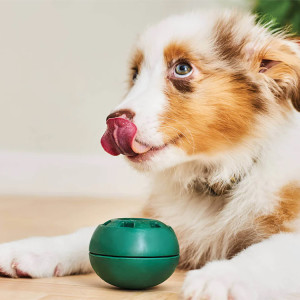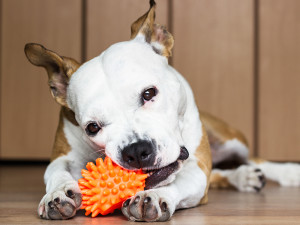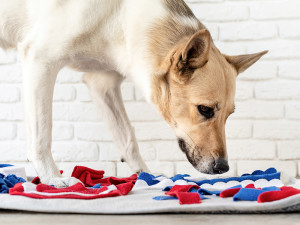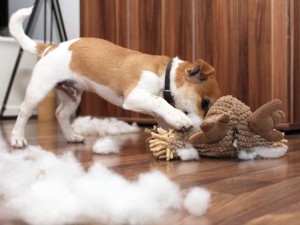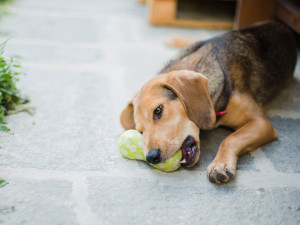How to Tell if Your Dog Is Bored
Get out the toys and puzzles.
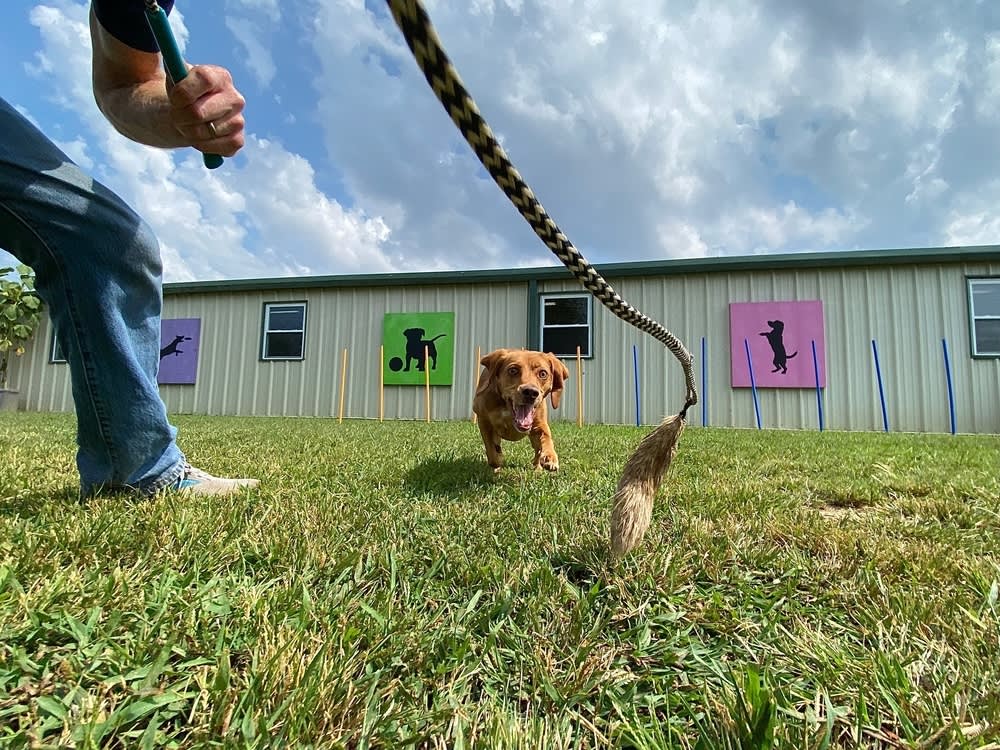
Share Article
In This Article:
Is Your Dog Bored? How to Tell How to Fix Your Dog’s Boredom
Among the many memes from the pandemic is a picture of a dog on top of a kitchen cabinet with the caption, “No, I’m not coming down! We’ve been on 20 walks today. Leave me alone.” Now that dog parents are working away from home again, their dogs might be having the opposite problem. Which begs the question: How can you tell if your dog is bored, and what can you do about it?
Is your dog bored? How to tell
Destruction is a classic sign of boredom (remember that great pair of sneakers you got on sale or that hole in your favorite cozy couch blanket?). Without a constructive outlet for their energy, dogs will make their own fun, which might not amuse you. My rescue dog, Lilac, shreds the bathroom trash. Boredom also tugs at the heartstrings. My other dog, Willy, stares at the wall and sighs.
Kate LaSala, a multi-certified behavior consultant specializing in fear and aggression and a companion animal end-of-life doula, owns Rescued by Training LLCopens in new tab. She says changes in behavior that may signal boredom include increased barking, destruction, lethargy, aggression, licking and chewing, and house soiling. Before assuming any of these behaviors are the result of boredom, however, consult with your vet to rule out underlying health issues.
“Often behavior is the canary in the coal mine and people notice behavior changes before obvious physical signs of pain or illness are present,” LaSala says. “Some serious behavior issues like separation anxiety can look like boredom, resulting in vocalization, destruction or attention-seeking so it’s important to work with a qualified behavior consultant to determine the underlying cause, if medical reasons have been ruled out.”
Your dog is damaging furniture
Dr. Gary Dattner, the chief veterinary officer at Tandem Vet Careopens in new tab, says chewing is a natural behavior that allows dogs to self-soothe when they feel anxious or under-stimulated.
“When your dog is chewing furniture or tearing up pillows, this likely means they are trying to release pent-up energy or stress. If dogs do not have access to appropriate chew toys or partake in sufficient exercise, they often redirect their chewing behavior towards household items,” Dattner says.
Your dog is overeating
A bored dog given free access to food may overeat. Or scavenge the trash. “Unlike humans, dogs do not fully grasp the concept of portion control, nor do they often eat for emotional reasons,” Dattner says. “Instead, they use food-related behavior as a way to get your attention or to provide them with something to do.”
Your dog keeps going to the bathroom around the house
When your dog poops and pees in the house, it’s a classic sign of boredom but, again, can indicate underlying health issues, especially in older dogs. “A dog trained to use the restroom outside who suddenly starts having accidents indoors is another sign of boredom,” Dattner says. “While there can be medical and emotional causes, boredom is an often-overlooked cause. Some dogs act out purely out of boredom, or even as a form of protest to being left alone for long periods of time.”
Your dog is doing things to seek attention
Dogs are social animals and often find comfort and engagement with people and other pets. “If your dog constantly tries to paw, bark, whine, or jump or simply follows you from room to room, they are likely trying to tell you they are bored,” Dattner says. “This is especially true for younger dogs or puppies.”
Your dog is sleeping excessively
Dogs naturally sleep a lot, especially puppies and older dogs. However, excessive sleeping can indicate boredom or depression, Dattner says. “A bored dog will tend to lie around most of the day because there is little or no engagement,” he says. “When there is nothing else stimulating their environment, the dog will often sleep to pass the time. Similar to humans, when they have nothing to do, they may take a nap. If your dog sleeps most of the day and is not interested in playtime, walks, or interaction with others, it's time to find increased stimulation options for their daily routine.”
Your dog is barking, whining, or doing other repetitive behaviors
Boredom barking, demand barking, digging and pawing gets people’s attention, which is exactly the point from your dog’s perspective. If you suspect boredom is the cause, you can fix your dog’s non-stop barking or other troublesome repetitive behaviors with any of the suggestions below for increasing exercise and mental stimulation to burn energy.
How to fix your dog’s boredom
If you’ve ruled out any underlying medical reason for your dog’s unusual behavior and you’re attributing it to boredom, you’ll find plenty of solutions to engage puppies and senior dogs alike.
Make sure they exercise.
There’s nothing like exercise to boost endorphins and serotonin. A simple walk does a lot to increase physical activity and stimulation for your dog through sniffing and social interaction. Most experts agree increased exercise is the first step to address boredom.
“To keep dogs healthy and happy, they need regular exercise,” Dattner says. “A little increase in your dog’s activity level each day — by just 10 minutes — can have a great impact. Activities such as walks, fetch games, and short agility courses can help your dog burn energy and stay mentally busy.”
Get them mental stimulation.
Fortunately, exercise also provides mental enrichment if you let your dog pause to sniff the fire hydrant. LaSala calls it a “sniffari.” “Think of your dog’s walks as a sniffing adventure, not a distance marathon. Walks aren’t about how far you go, it’s about how much sniffing and exploring the dog is allowed to do,” she says.
Some dogs are satisfied with food enrichment toys and treat-dispensing puzzles. Others need jobs like classes in scent work and agility, lure coursing, barn hunts, or tricks. More time at a safe dog park, and a different walking route can alleviate boredom.
“Lack of enrichment (mental and physical) or lack of access to breed-specific behaviors like sniffing, dissecting, hunting, scavenging, chewing, and chasing can all lead to a reduced quality of life for the dog and increased frustration for dog and owner,” LaSala says.
Get them social activity.
Social interaction is vital for dogs, as they’re social animals and thrive on engaging with others. They enjoy meeting people on the sidewalk and trips to stores that allow dogs. “Arranging playdates for your dog is a fun way to help them satisfy the need for companionship and social interaction,” Dattner says.
Find games and toys for them.
In addition to the stimulation a dog gets from interacting with a toy, chewing releases feel-good chemicals in the brain, which keeps dogs busy and happy. Food-dispensing balls are designed for solitary play. With so many toys on the market, choosing toys can be hard. Select the correct size to prevent a small toy from lodging in your dog’s throat. Check for small parts that can be chewed off and become choking hazards or create blockages in the intestines. When introducing a new toy, supervise your dog’s initial interactions and check the toy periodically to make sure it’s safe.
Types of toys include interactive, food-stuffing toys, such as Kong or the Toppl treat-dispensing toyopens in new tab from West Paw. In hot weather, freeze a Kong stuffed with wet dog food, pieces of meat floating in stock, or vegetables covered with water. Puppies, who usually need additional entertainment and appropriate direction when it comes to chewing, can eat an entire meal and stay busy with this method.
Dattner suggests hiding treats in pet-safe household containers for your dog to find, similar to a scavenger hunt. “Toys that require problem-solving are a great way to keep your dog occupied while preventing boredom-based issues,” he says.
Puzzles from Nina Ottosson and the Aikiou brands are great for a bright and active puppy. Make the toys more appealing by rubbing peanut butter on them. When you first introduce your dog to these toys, make it easy for them to obtain the treats, then gradually increase the difficulty so they learn how to work persistently to extract the food. Otherwise, your dog may get frustrated, leading to the opposite of what we intend to do through enrichment and stimulation.
Get them some entertainment.
Entertainment is akin to mental enrichment. Like humans, dogs love entertainment and enjoy playing games, going to different places, and learning new things, Dattner says. “Enrolling your dog in a sport such as fly ball, dock diving, or agility is another great way to keep your dog entertained and prevent boredom,” he says.
For more passive entertainment, whole channels such as DOGTVopens in new tab are now devoted to dogs. Spotify has a playlist for dogs who are home alone. Play different types of music at low volume around your dog to see how they react; pets have more acute hearing than humans and need a break from auditory stimuli. Studies show that classical music reduces stress levels and increases resting and sleeping in dogs.
Bottom line
Dogs of all ages, including senior dogs, can benefit from more mental and physical stimulation if you or your vet has determined they’re suffering from boredom or loneliness. Boredom can show up in unwanted behaviors such as barking, destroying household items, apathy, aggression, licking and chewing, and pooping or peeing inside.
Fortunately, there’s a lot you can do to prevent boredom — including giving your pup more exercise and mental stimulation, keeping them busy at home alone with toys and puzzles, and finding soothing entertainment.
References
“5 Reasons Why Your Dog Won’t Stop Barking.” www.petmd.com, www.petmd.com/dog/behavior/reasons-your-dog-wont-stop-barkingopens in new tab.
Sugar, Rachel. “Do Dogs and Cats Get Bored? What Experiences We Owe Our Pets.” The Cut, 12 Aug. 2024, www.thecut.com/article/do-dogs-get-bored-cats-experiences.htmlopens in new tab. Accessed 15 July 2025.
Youngerman, Claire. “Abnormal Eating Habits in Dogs.” Animal Health Topics / School of Veterinary Medicine, 8 Apr. 2019, healthtopics.vetmed.ucdavis.edu/health-topics/canine/unusual-eating-habits-dogsopens in new tab.
Youngerman, Claire. “Digging in Dogs.” Animal Health Topics / School of Veterinary Medicine, 8 Apr. 2019, healthtopics.vetmed.ucdavis.edu/health-topics/canine/why-does-my-dog-digopens in new tab.
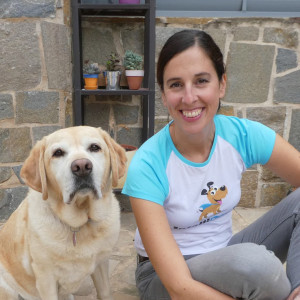
Iza Arrieta, Msc
Although Iza Arrieta, co-owner of Intellipuppy.com, has a BA and a master’s degree in law, her real passion has always been helping dogs. In 2007, she graduated from Bocalan Madrid as a dog trainer, and in 2011, was awarded a postgraduate diploma in companion animal behavior counseling by the University of Southampton in the UK.
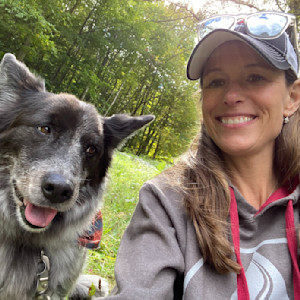
Catherine Fahy Green
Catherine Fahy Green is a journalist turned copy and content writer. Her work as a PR specialist appears in national trade media as press releases and stories about exciting new products people should try. She lives with her family in Western Massachusetts, where she listens closely to the stories her two dogs, flock of chickens, and four horses tell her.
Related articles
![A woman wearing a knit sweater holding a dog close on the floor of her bedroom.]()
Separation Anxiety in Dogs
Train your dog to stay calm when they’re on their own — instead of sad-singing “All By Myself” until you come home.
![training dog chewing blanket]()
Why Does My Dog Chew On Blankets?
A (seemingly) unstoppable nibbling obsession with all the blankets.
![Woman walking her dog in a park]()
Dog Walking 101: How Often Should You Walk Your Dog?
And why you shouldn’t skip the longer routes.
![Senior mixed breed dog playing with washable snuffle rug for hiding dried treats]()
How to Help Your Bored Senior Dog Spice Up Their Life
Spice Girls reference aside, just because your dog is graying around the eyes doesn’t mean those eyes don’t light up at playtime.
![White and brown puppy destroyed a stuffed toy]()
How to Stop Your Dog From Ripping Up Their Toys
How to teach your dog to enjoy, not destroy, their toys.
![Dog laying on the ground guarding toy in mouth]()
How to Get Your Dog to Stop Resource Guarding Their Stuff
If your dog growls when you get near their food or toys, read this right now.

